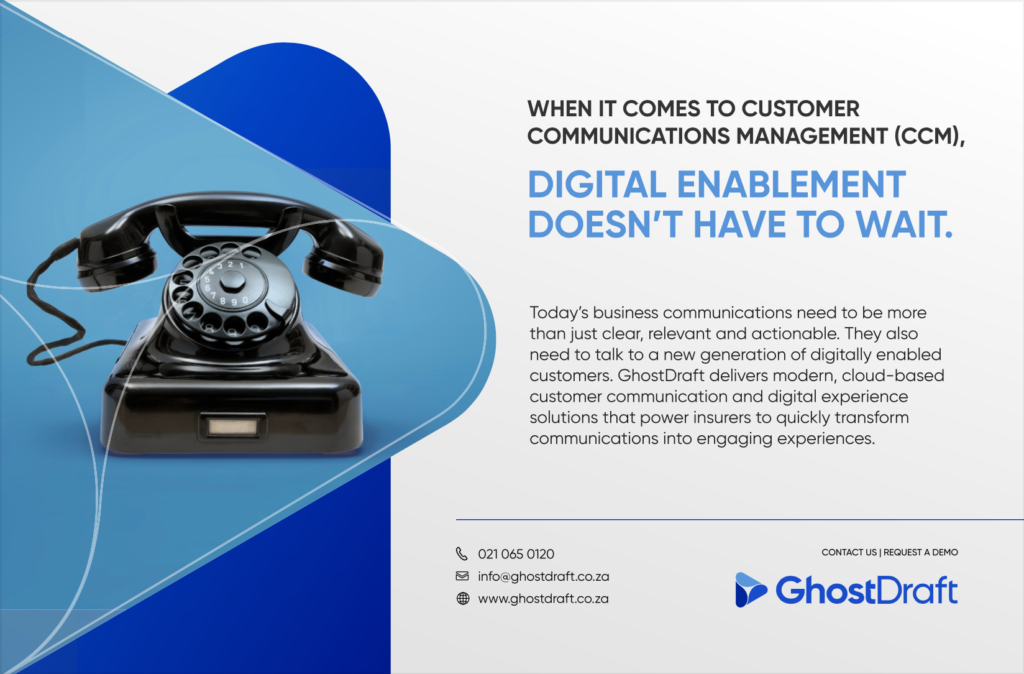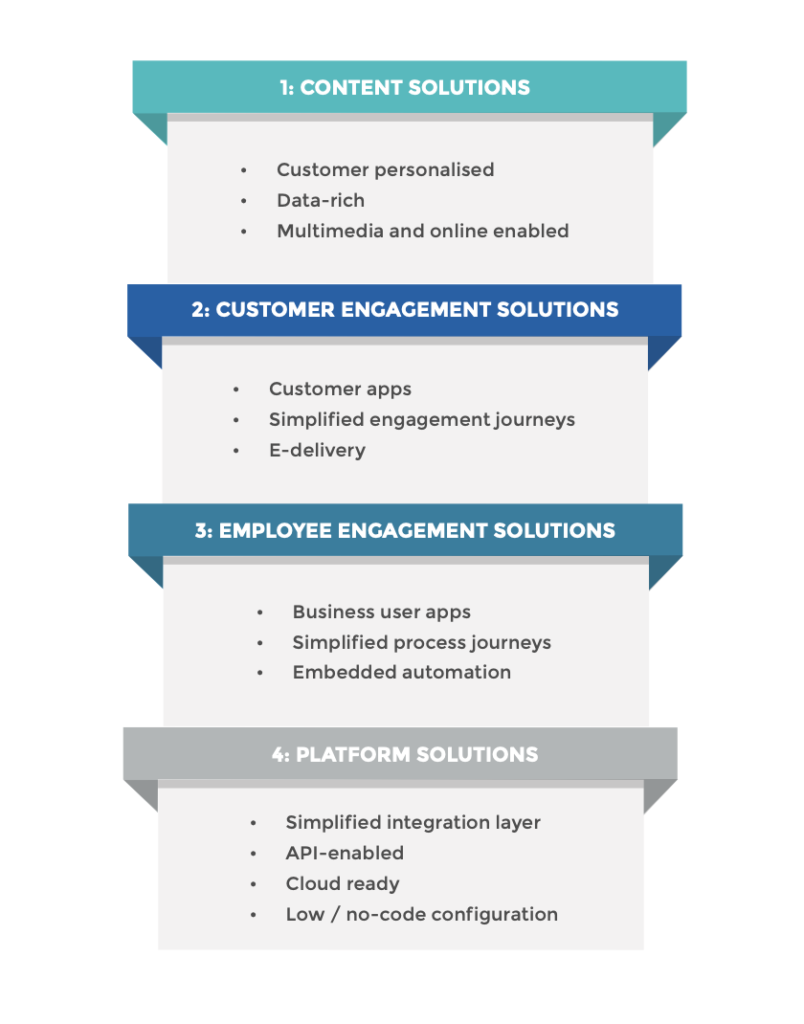Every participant in the insurance industry is evaluating digitisation as an essential part of their long term strategy. I spent some time with Wayne Toms, CEO of Ghostdraft South Africa, to explore the industry’s quest for sustainable digital transformation.

Tony: What is Digital Transformation, and why is it so topical in insurance right now?
Wayne: Put simply, it’s using technologies to automate processes and create digital customer experiences to meet changing business and market needs. For example, a customer who wants to buy an insurance policy may want have the following experience with the insurer:
- Online access to a form to submit certain information
- Quick or even real-time assessment, underwriting of their application
- Quick turnaround of policy documents, with personalised product offerings
- E-delivery of those documents
- Dynamic document content, including multimedia, interactivity options, etc.
- The ability to manage their affairs online.
On the question, why has Digital become topical for insurers? Well, the way customers buy insurance today is changing, everyone has smart phones and apps, and these have become the default go-to for shopping. This has led customers to expect more from their interactions with insurers – customers hate friction, and they want to be able to dictate their needs, and correspondence – including contracts, like policies, claims etc – needs to be brief and easy to read.
The thing is that new market disruptors have tied into this changing need. With less dependence on legacy systems they have specifically set out to disrupt business models, pricing and customer selection dynamics. So, as rising customer expectations, intense competition, and economic volatility continue to change the insurance landscape, carriers of all sizes across the industry are shifting focus to three core areas:
- Building exceptional customer experiences that drive growth and retention
- Driving process efficiency and cost reduction, and
- Accelerating digital transformation through innovation.
Digital transformation, then, means changing our business systems to enable this, and also making commensurate changes to our people, structures and business processes.
Tony: Why have insurers been slow to respond?
Wayne: The aim of insurers, like banks, is to reduce risk. The inevitable impact of this has been to slow down innovation. This is frequently seen in the core insurance IT systems, which are notoriously slow to change or extend. Research has found that it takes insurers an average of 8 months to bring even simple new insurance products to market, and 4 months for modified products. Half of this time is spent in implementation and testing, where the product is coded or configured in insurer systems.
However, insurers now need to find a way to adapt to these new customer requirements, while continuing to meet their fiduciary responsibilities. The problem is, the way many core insurance systems have been architected means that Digital requirements cannot usually be easily enabled by these systems. New systems are required but, replacing core systems is hugely complex and costly. This change process is made more complex by the need to support the complex insurance product structures in new system, and to migrate policies in force across to these systems.
Tony: Given this legacy investment, what options do insurers have to offer digital enablement to customers and their businesses?

Digital enablement doesn’t have to wait.
Today’s business communications need to be more than just clear, relevant and actionable. They also need to talk to a new generation of digitally enabled customers.
GhostDraft delivers modern, cloud-based customer communication and digital experience solutions that power insurers to quickly transform communications into engaging experiences.
Wayne: Digital transformation can be a hugely disruptive journey for insurers, because of the difficulty of changing existing systems, structures and processes. We would argue that digital transformation be seen not as a single, huge investment, but as a series of small, incremental steps. The key is to find a way to enable digital customer engagement without changing core systems. Luckily, modern IT has provided a way to do this, with the development of what are called open APIs which, with standard methods, allow computer systems to talk to each other. They are widely supported and are relatively easy to work into existing IT ecosystems. This interaction layer can enable us to separate digital functionality into a separate set of systems and to layer these systems on top of existing systems without the need for extensive and invasive system surgery.
Tony: The next step is probably to look at the solutions available to insurers. What are the types of digital enablement solutions that are available to insurers?
Wayne: In order for a process to be digitally transformed, there are four types of application or system functionality that we should consider:
The four types of application or system functionality to consider:

At GhostDraft, we focus specifically on the automation of insurance documents and correspondence. This is obviously a key point of customer interaction. So our solutions are able to provide a front-end application for customer interaction, as well as a simplified browser-based solution for insurance business users. Both of these can easily be integrated into insurance back-end systems. In fact, we have already done this for many leading PAS systems and we’re able to deliver all document content as personalised and multimedia-enabled.
Tony: Where would you recommend that an insurer get started?
Wayne: The first step is indeed to get started. We suggest to our clients that they identify a customer interaction point where value is easy to articulate, for example engaging with new customers to produce a quote. Rather than reengineering or radically altering core systems, look to leverage an existing 3rd party solution which can handle the full digital journey with the customer. These systems are designed from the ground up to work with other systems.
That leaves a much simpler requirement in the hands of IT, to provide a simplified integration layer on top of existing core systems. In our interactions with insurers we see many of them building out their functionality to allow systems like these to be easily integrated into their environments. This does not have to be a forever solution. The beauty of separating digital into its own layer is that these systems should be replaceable with limited impact on the core.
Tony: How about brokers and other intermediaries? How might this apply to them?
Wayne: Brokers’ customers have the same needs as those who interface directly with the insurance carriers and, in our experience, with some careful planning, it is often quite possible for brokers to own the digital front-end and to integrate this into the carrier’s policy and claims systems.
One of the benefits of digital solutions is that they often require less up-front investment and are extremely versatile. So, these systems are actually within the reach of mid-size intermediaries and can give them the ability to flex to a variety of current and future customer requirements.
In summary
While the digital transformation journey can seem complex and expensive it doesn’t get any easier by doing nothing. If we can disaggregate the journey into a series of more manageable initiatives and investments then we can deliver customer benefit more expediently, while also building out a flexible set of systems that can be used in future to adapt to growing customer and business requirements.
“When it comes to Customer Communication Management (CCM), Digital Enablement doesn’t have to wait”

